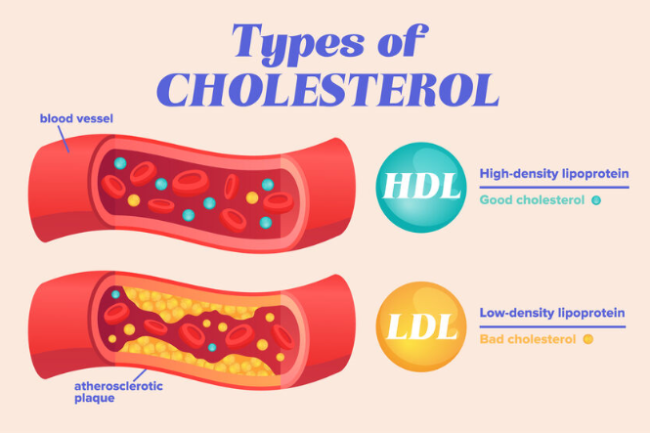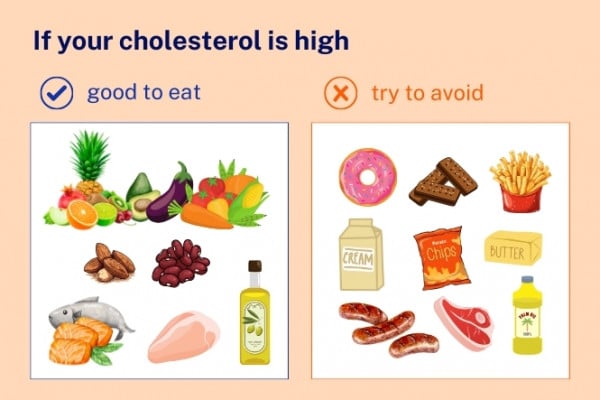Cholesterol – high | Ngakototo nui
Also known as hyperlipidemia
Key points about high cholesterol (ngakototo nui)
- Cholesterol is a type of fat in your blood. There are 2 types – HDL ('good' cholesterol) and LDL ('bad' cholesterol).
- High cholesterol is when you have too much LDL and/or too little HDL.
- Your body needs some cholesterol but if the amount in your blood gets too high, over time it can narrow and harden your arteries. This increases your risk of heart attack or stroke.
- Lifestyle changes can help lower your cholesterol. Some people also need to take medicines.
- Talk to your healthcare provider about your overall cardiovascular risk and what you can do to keep your cholesterol in the healthy range.

What is high cholesterol?
Cholesterol is a form of fat found in the body which is needed to build cells, make some hormones and help with digestion and metabolism. Cholesterol is carried around the body in the blood stream by lipoproteins, which act like ‘couriers’. There are 2 types: low-density lipoprotein (LDL) cholesterol and high-density lipoprotein (HDL) cholesterol.
High cholesterol (known as hypercholesterolemia or dyslipidemia) is when there's too much LDL cholesterol and/or not enough HDL cholesterol in your blood. LDL is often referred to as the ‘bad’ cholesterol, while HDL is known as the ‘good’ cholesterol’. Learn more about LDL and HDL cholesterol.
When you have too much LDL cholesterol in your blood, it can stick to the inside of your artery walls. As it builds up, it causes the arteries to narrow and harden (atherosclerosis). This makes it harder for blood to flow through your arteries and increases your risk of heart disease or stroke.

Image credit: 123rf
What causes high cholesterol?
Causes of high cholesterol can differ from person to person. Some causes can be changed, while others can’t.
Causes you can change include:
- how much refined sugar or unhealthy fats you eat
- how much alcohol you drink
- how much physical activity you get
- being overweight, especially if you carry a lot of weight around your middle (abdomen)
- smoking.
Causes you can’t change include:
- your age – as you get older your liver is less able to remove LDL from your blood
- your gender – women tend to have higher HDL than men until they reach menopause, when total and LDL cholesterol levels can rise and HDL levels can drop.
- your genes (family history).
Some medical conditions (eg, diabetes, chronic kidney disease, hypothyroidism) can cause unhealthy levels of cholesterols, as can some medicines. Talk to your healthcare provider if you're concerned about this.
The types of fat in your food affect your cholesterol level in different ways.
- Trans fats raise your bad (LDL) cholesterol and lower your good (HDL) cholesterol. These man-made fats are found in commercially fried foods, snacks and baked goods. They are the worst kind for your health and should be avoided if possible.
- Saturated fats increase LDL cholesterol and are not good for your health. They are found in red meat, cheese, butter, fried and baked goods and some vegetable oils.
- Monounsaturated fats help lower LDL cholesterol and are a good source of fat, especially if they are used to replace saturated fats. They are found in nuts, olives, avocado and olive and canola oils.
- Polyunsaturated fats (with Omega-6) help lower bad cholesterol, but may also decrease good cholesterol if eaten in large amounts. They’re found in corn, soybean and safflower margarine and oils.
- Polyunsaturated fats (with Omega-3) can reduce triglycerides and can have a variable impact on LDL cholesterol. They are found in oily fish, (eg, salmon and mackerel), and in flaxseed, walnuts, walnut oil, soybean and soybean oil.
- Plant sterols help to block the absorption of cholesterol and can decrease LDL cholesterol. They're sometimes added to margarine, and are found naturally in plant foods, eg, in sunflower seeds.
Read more about fats and oils.

Image credit: Healthify He Puna Waiora
High cholesterol doesn’t usually have any symptoms. The only way to find out if your cholesterol is high is to have a blood test called a lipid profile or lipid panel. This test measures the amount of cholesterol and triglycerides (another type of fat) in your blood. Read more about cholesterol testing, and understanding your cholesterol test results.
You may be able to reduce your cholesterol by making changes to your lifestyle. These include:
- eating a healthy balanced diet with plenty of fresh fruit and vegetables
- cutting back on food and drinks that are high in sugar, salt or unhealthy fats
- exercising more (start small and aim for 150 minutes over a week)
- losing weight (if you're overweight).
- if you smoke, quit.
Apps reviewed by Healthify
You may find it useful to look at some Nutrition, exercise and weight management apps, Quit smoking apps, and this BMI calculator.
Your healthcare provider will assess your risk of heart attack or stroke based on your lipid profile results and other risk factors including your age, gender, ethnicity, cholesterol levels, smoking history, blood pressure, family health history and other health conditions. This is known as a cardiovascular risk assessment (CVR assessment or heart risk assessment) and different people need the assessment at different ages. Find out more about heart risk assessment.
Your healthcare provider may also recommend taking medicine (eg, a statin) to help lower your cholesterol and reduce your risk of having a heart attack or stroke.
Read more about cholesterol lowering medicines.
My heart check
As well as seeing your healthcare provider for a heart risk assessment, you can check your heart health with a free online heart health check designed for New Zealanders by the Heart Foundation.
It can estimate your heart age compared to your actual age, as well as giving you an estimate of your risk of having a heart attack or stroke in the next 5 years. Note that this tool works best for people 30–75 years of age. You can still use it if you are older or younger, but your result may be less accurate.
Use My Heart Check(external link) to find out about your heart health.
Cholesterol(external link) Heart Foundation NZ
Cholesterol management(external link) Heart Foundation, NZ
Cholesterol – explained(external link) American Heart Association, US
The Portfolio Diet(external link) DJA Jenkins and University of Toronto
Brochures
Cholesterol(external link) Heart Foundation, NZ English(external link), Chinese(external link), Hindi(external link), Korean(external link), te reo Māori(external link), Samoan(external link), Tongan(external link)
Lowering your risk of heart attack and stroke(external link) Heart Foundation, NZ
Apps/tools
BMI calculator
Nutrition, exercise and weight management apps
Quit smoking apps
Stroke apps
References
- High cholesterol: Symptoms, causes and treatment(external link) Heart Foundation, NZ
- Cholesterol(external link) Better Health Channel, Australia
- High cholesterol(external link) Mayo Clinic, US, 2023
- What is high cholesterol?(external link) NHS, UK, 2022
- High cholesterol and heart disease in women(external link) Healthline, US, 2021
- Women and heart disease(external link) Heart Research Institute, NZ
NZ Primary Care Handbook
NZ Primary Care Handbook(external link) Health New Zealand | Te Whatu Ora, 2012
Cardiovascular Disease Risk Assessment and Management for Primary Care(external link) Health New Zealand | Te Whatu Ora, 2018
Resources
Cardiovascular disease risk assessment in primary care – managing lipids(external link) BPAC, NZ, 2018
Prescribing statins to reduce cardiovascular risk(external link) BPAC, NZ, 2021
CVD workbook – understanding and communicating CVD risk and management recommendations(external link) He Ako Hiringa, NZ, 2022
2021 Position Statement on Lipid Treatment Targets in Individuals at High Cardiovascular Risk. New Zealand:(external link) New Zealand Region Cardiac Society of Australia and New Zealand (CSANZ), 2021.
Management of dyslipidaemia in primary care(external link), Heart Foundation, NZ, 2018
Cardiovascular disease (CVD) risk assessment tool information(external link) Health New Zealand | Te Whatu Ora, 2023
NZ heart risk calculator(external link) (Need to select New Zealand PREDICT)
Apps/tools
BMI calculator
Nutrition, exercise and weight management apps
Quit smoking apps
Stroke apps
Credits: Healthify editorial team. Healthify is brought to you by Health Navigator Charitable Trust.
Reviewed by: Claire Salter, Pharmacist, Tauranga
Last reviewed:
Page last updated:





